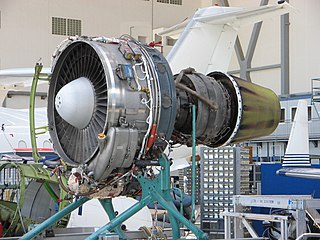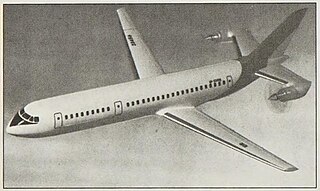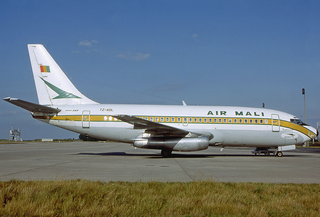
The Ilyushin Il-62 is a Soviet long-range narrow-body jetliner conceived in 1960 by Ilyushin. As successor to the popular turboprop Il-18 and with capacity for almost 200 passengers and crew, the Il-62 was the world's largest jet airliner when first flown in 1963. The seventh quad engined, long-range jet airliner to fly, it was the first such type to be operated by the Soviet Union and a number of allied nations.

A propfan, also called an open rotor engine, open fan engine or unducted fan, is a type of aircraft engine related in concept to both the turboprop and turbofan, but distinct from both. The design is intended to offer the speed and performance of a turbofan, with the fuel economy of a turboprop. A propfan is typically designed with a large number of short, highly twisted blades, similar to the (ducted) fan in a turbofan engine. For this reason, the propfan has been variously described as an "unducted fan" (UDF) or an "ultra-high-bypass (UHB) turbofan".

The Rolls-Royce AE 2100 is a turboprop developed by Allison Engine Company, now part of Rolls-Royce North America. The engine was originally known as the GMA 2100, when Allison was a division of former corporate parent General Motors.

The Boeing 7J7 was an American short- to medium-range airliner proposed by American aircraft manufacturer Boeing in the 1980s. It would have carried 150 passengers and was touted as the successor to the successful Boeing 727. It was initially planned to enter service in 1992. This was intended as a highly fuel-efficient aircraft employing new technologies, but it was postponed indefinitely as the price of oil dropped during the 1980s.

The Tupolev Tu-334 was a Russian short-to-medium range airliner project that was developed to replace the aging Tu-134s and Yak-42s in service around the world. The airframe was based on a shortened Tu-204 fuselage and a scaled-down version of that aircraft's wing. Unlike the Tu-204, however, the Tu-334 has a T-tail and engines mounted on the sides of the rear fuselage instead of under the wings. With the nationalisation of the Russian aircraft companies in 2009 to form United Aircraft Corporation it was decided not to continue with the programme.

The Ilyushin Il-114 is a Russian twin-engine turboprop airliner, designed for local routes. Intended to replace the Antonov An-24, it first flew in 1990. A total of 20 Il-114s have been built.

The McDonnell Douglas MD-94X was a planned propfan-powered airliner, intended to begin production in 1994. Announced in January 1986, the aircraft was to seat between 160 and 180 passengers, possibly using a twin-aisle configuration. An all-new design that was investigated internally since at least 1984, the MD-94X was developed in the mid-1980s to compete with the similar Boeing 7J7. The price of oil would have to be at least US$1.40 per gallon for McDonnell Douglas to build the plane, though. Configuration was similar to the MD-80, but advanced technologies such as canard noseplanes, laminar and turbulent boundary layer control, side-stick flight control, and aluminum-lithium alloy construction were under consideration. Airline interest in the brand-new propfan technology was weak despite claims of up to a 60% reduction in fuel use, and both aircraft were canceled.

The General Electric GE36 was an experimental aircraft engine, a hybrid between a turbofan and a turboprop, known as an unducted fan (UDF) or propfan. The GE36 was developed by General Electric Aircraft Engines, with its CFM International equal partner Snecma taking a 35 percent share of development. Development was cancelled in 1989.
The Yakovlev Yak-46 was a proposed aircraft design based on the Yak-42 with two contra-rotating propellers on the propfan located at the rear. The specification of the Samara turbofans was in the 11,000 kg thrust range. Though proposed in the 1990s, production of the Yak-46 never commenced.

The Embraer/FMA CBA 123 Vector was a 1990 turboprop aircraft designed for regional flights, to carry up to 19 passengers. The program arose from a partnership between the Brazilian company Embraer and the Argentine FMA. The project was an advanced turboprop aircraft for its time, including advanced technology in avionics, aerodynamics, and propulsion.

The Progress D-27 is a three-shaft propfan engine developed by Ivchenko Progress, and manufactured by Motor Sich in Ukraine. The gas generator was designed using experience from the Lotarev D-36 turbofan. The D-27 engine was designed to power more-efficient passenger aircraft such as the abandoned Yakovlev Yak-46 project, and it was chosen for the Antonov An-70 military transport aircraft. As of 2019, the D-27 is the only contra-rotating propfan engine to enter service.

The Lycoming ALF 502/LF 507 is a geared turbofan engine produced by Lycoming Engines, AlliedSignal, and then Honeywell Aerospace. The U.S. military designation for the ALF 502 is YF102.

The Antonov An-180 was a Ukrainian design for a twin-aisle medium-range propfan airliner. Although the design was completed by the Antonov Design Bureau in 1994, the type was not built.

The Pratt & Whitney/Allison 578-DX was an experimental aircraft engine, a hybrid between a turbofan and a turboprop known as a propfan. The engine was designed in the 1980s to power proposed propfan aircraft such as the Boeing 7J7 and the MD-91 and MD-92 derivatives of the McDonnell Douglas MD-80. As of 2019, it is still one of only four different contra-rotating propfan engines to have flown in service or in flight testing.

Société Nationale Air Mali, or Air Mali as it was most commonly known, was the former national airline of the Republic of Mali. It had its head office in Bamako.
MPC 75 was an aircraft project of MPC Aircraft GmbH, a subsidiary of Deutsche Airbus. Work on the project was done mainly between 1988 and 1992 in Hamburg, Germany. Predevelopment work was finished, however the project never got the "go ahead" and never made it into full development.

The Progress D-236 was an experimental aircraft engine, a hybrid between a turbofan and a turboprop known as a propfan. Also known as the Lotarev D-236T, the three-shaft geared engine was designed in the 1980s and 1990s to power proposed propfan aircraft such as the Tupolev Tu-334, Ilyushin Il-118, and Ilyushin Il-88.

The Kuznetsov NK-93 was a civilian aircraft engine, a hybrid between a turbofan and a turboprop known as a propfan. The engine was also unique in having a separate duct around the contra-rotating propellers, as most other propfans are unducted. Once described in a respected aviation encyclopedia as "potentially the most fuel-efficient aircraft jet engine ever to be tested", the NK-93 was targeted for derivatives of Soviet/Russian airliners such as the Ilyushin Il-96, Tupolev Tu-204, and Tupolev Tu-330. Five in-flight engine tests were conducted on the NK-93 from December 2006 to December 2008.
The Kuznetsov NK-92 was a military engine with a super-high bypass ratio. The NK-92 was proposed to power the Ilyushin Il-106 heavy military transport aircraft. Development of the Il-106 aircraft and its NK-92 engine slowed in the early 1990s. However, aspects of the engine's design were applied to the NK-92's civil engine counterpart, the Kuznetsov NK-93, which was tested in flight in the first decade of the 2000s.
The MTU/Pratt & Whitney RTF-180 was a planned turbofan aircraft engine that was to be jointly developed by Motoren-und Turbinen Union (MTU) and Pratt & Whitney in the early 1990s. It was to be the first civil engine program where MTU would be the prime contractor. The name of the engine, RTF-180, combined the initials for "Regional TurboFan" with the engine's nominal thrust of 18,000 pounds-force.














